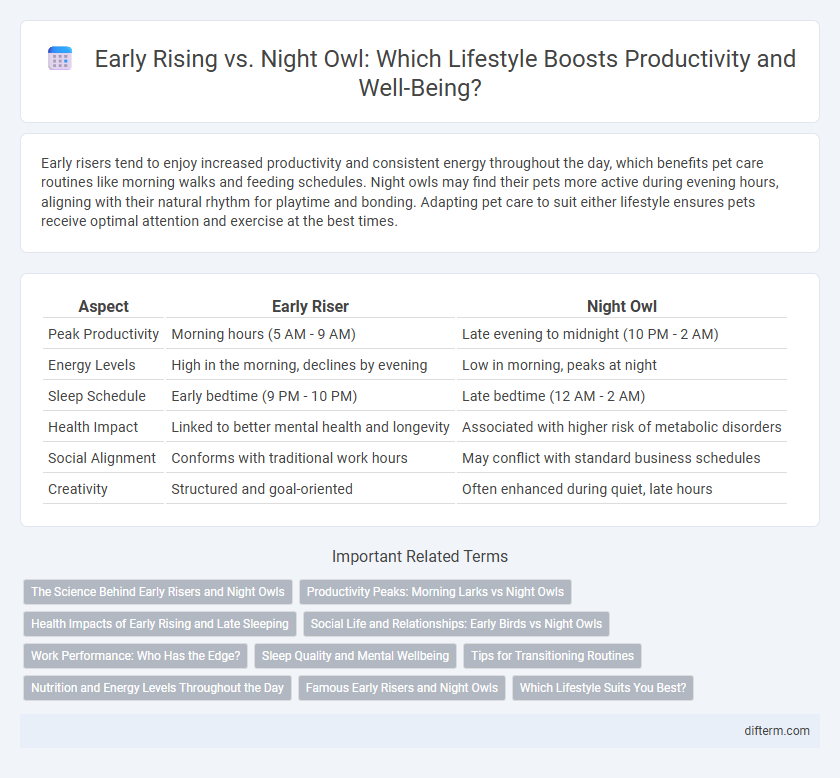Early risers tend to enjoy increased productivity and consistent energy throughout the day, which benefits pet care routines like morning walks and feeding schedules. Night owls may find their pets more active during evening hours, aligning with their natural rhythm for playtime and bonding. Adapting pet care to suit either lifestyle ensures pets receive optimal attention and exercise at the best times.
Table of Comparison
| Aspect | Early Riser | Night Owl |
|---|---|---|
| Peak Productivity | Morning hours (5 AM - 9 AM) | Late evening to midnight (10 PM - 2 AM) |
| Energy Levels | High in the morning, declines by evening | Low in morning, peaks at night |
| Sleep Schedule | Early bedtime (9 PM - 10 PM) | Late bedtime (12 AM - 2 AM) |
| Health Impact | Linked to better mental health and longevity | Associated with higher risk of metabolic disorders |
| Social Alignment | Conforms with traditional work hours | May conflict with standard business schedules |
| Creativity | Structured and goal-oriented | Often enhanced during quiet, late hours |
The Science Behind Early Risers and Night Owls
Research reveals that early risers, or "larks," typically exhibit higher morning cortisol levels, promoting enhanced alertness and cognitive performance shortly after waking. In contrast, night owls tend to have delayed melatonin production, causing a natural shift in their circadian rhythm that favors peak activity during late evening hours. Genetic factors, including variations in the PER3 gene, significantly influence individual chronotypes, affecting sleep patterns and overall lifestyle productivity.
Productivity Peaks: Morning Larks vs Night Owls
Morning larks experience peak productivity during early hours, leveraging higher cognitive function and energy levels shortly after waking. Night owls reach their productivity zenith in the evening or late at night, often benefiting from fewer distractions and a calmer environment. Understanding individual chronotypes allows tailored work schedules that optimize focus, creativity, and efficiency.
Health Impacts of Early Rising and Late Sleeping
Early rising aligns with the body's natural circadian rhythm, promoting better sleep quality, enhanced mental clarity, and reduced risk of chronic illnesses such as cardiovascular disease and diabetes. Night owls often experience social jetlag, increased stress levels, and higher rates of metabolic disorders due to misalignment with societal schedules. Consistent sleep patterns and exposure to morning light improve hormonal balance and immune function, contributing to overall health and longevity.
Social Life and Relationships: Early Birds vs Night Owls
Early birds tend to have more synchronized social schedules, fostering stronger daytime interactions and consistent relationship routines. Night owls often experience challenges aligning with typical social hours, which can lead to fewer face-to-face engagements and potential social isolation. Understanding these chronotype differences helps tailor social activities and improve relationship dynamics.
Work Performance: Who Has the Edge?
Early risers tend to have a performance advantage in traditional 9-to-5 work environments due to alignment with standard business hours and increased morning alertness. Night owls often excel in creative tasks and jobs with flexible schedules, leveraging peak cognitive function during late hours. Studies link early rising with higher productivity and better time management, while night owls may face challenges in early-morning meetings but exhibit strong problem-solving skills during their optimal periods.
Sleep Quality and Mental Wellbeing
Early rising aligns with the body's natural circadian rhythms, often resulting in improved sleep quality and enhanced mental wellbeing due to consistent sleep patterns and increased exposure to morning light. Night owls may experience disrupted sleep cycles and increased risk of mood disorders because their schedules conflict with typical social and work timings. Prioritizing sleep hygiene and aligning sleep schedules with individual chronotypes can optimize both rest and psychological health.
Tips for Transitioning Routines
Gradually adjusting sleep and wake times by 15 to 30 minutes daily helps ease the body's internal clock during a routine transition from night owl to early riser or vice versa. Exposure to natural light in the morning and limiting screen time before bed regulate melatonin production, promoting better sleep quality. Consistent mealtimes and a relaxing pre-sleep routine further support the shift to a new circadian rhythm aligned with desired lifestyle goals.
Nutrition and Energy Levels Throughout the Day
Early risers often experience stabilized energy levels due to consistent meal timings that enhance metabolic efficiency, supporting better nutrient absorption and sustained glucose regulation. Night owls tend to face irregular eating patterns, which can disrupt circadian rhythms and lead to fluctuating energy, often causing reliance on high-sugar foods for quick boosts. Optimizing nutrition by aligning meal schedules with natural wake cycles improves overall energy balance and cognitive function throughout the day.
Famous Early Risers and Night Owls
Famous early risers like Benjamin Franklin, Tim Cook, and Oprah Winfrey harness the quiet morning hours to boost productivity and creativity. In contrast, night owls such as Winston Churchill, Nikola Tesla, and Barack Obama find their peak performance late at night, often working well into the early morning. These lifestyle patterns highlight how aligning daily routines with one's natural chronotype can enhance efficiency and well-being.
Which Lifestyle Suits You Best?
Early rising aligns with productivity peaks in the morning, supporting routines that benefit from natural light and quiet hours, while night owls thrive in creative energy during late hours, often excelling in tasks requiring focus without interruptions. Assessing personal energy patterns, work demands, and social commitments helps determine whether a morning or evening lifestyle enhances well-being and efficiency. Tailoring sleep schedules to individual circadian rhythms optimizes mental clarity, physical health, and overall lifestyle satisfaction.
early rising vs night owl Infographic

 difterm.com
difterm.com